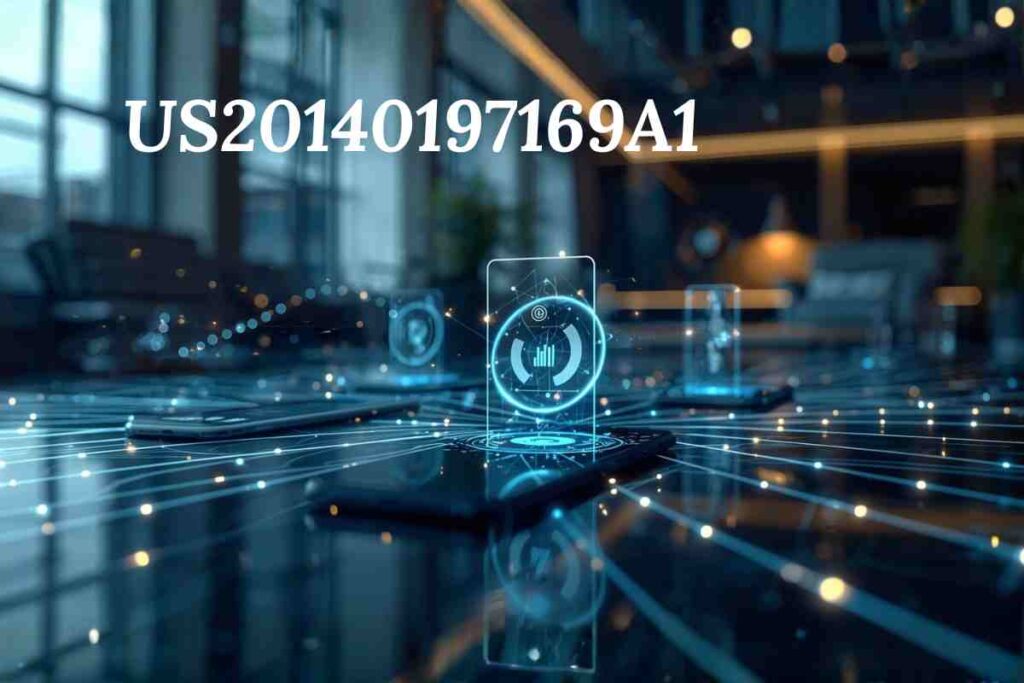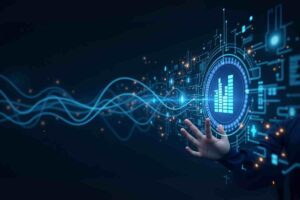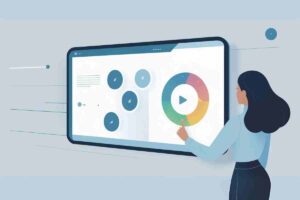US20140197169A1 might sound like a random string of letters and numbers, but it’s actually a fascinating patent that changes how devices connect with each other. In simple terms, it describes a system where mobile devices can recognize and associate with one another based on their shared environment things like sound, light, Wi-Fi signals, or even air pressure.
Instead of relying on GPS or Bluetooth pairing, this invention allows devices to link intelligently just by “noticing” they’re in the same place. That idea opens doors to smarter phones, privacy safe tracking, and seamless connections between gadgets. Let’s break down what this patent is, who created it, and why it matters.
What is US20140197169A1?
US20140197169A1 is a U.S. patent application titled Systems and Methods for Associating Mobile Devices Using Environmental Data. It was filed to protect a method that lets devices recognize each other by comparing environmental signals they independently collect.
Each device like a smartphone or smartwatch gathers data from sensors such as microphones, magnetometers, or light sensors. This data is analyzed and compared. If two devices detect similar environmental conditions, the system concludes they are near each other and links them automatically.
That means your phone could, theoretically, find another nearby device just by “hearing” the same background noise or detecting the same Wi-Fi signals no GPS, QR codes, or manual pairing required.
The Core Idea Behind the Patent
The key concept of US20140197169A1 is contextual similarity. Instead of forcing devices to share location data or user credentials, the patent relies on passive signals from the world around them.
Imagine being at a concert. Everyone’s phones pick up similar audio frequencies, lighting patterns, and Wi-Fi networks. Based on those shared environmental readings, your device could identify others at the same event and create a local connection automatically.
This is done by comparing the “fingerprints” of environmental data from each device within a short time window. If they match closely enough, the system assumes both devices are co-located.
How the System Works
The process described in the patent can be simplified into a few steps:
- Data Collection:
Each device gathers sensor data sound, light, magnetic field, pressure, Wi-Fi, and Bluetooth signals. - Preprocessing:
Before sending the data, devices may clean or compress it. This helps reduce battery use and network load. - Data Comparison:
A server or local processor compares data from multiple devices using algorithms like correlation or similarity scoring. - Association Decision:
If two or more devices show matching patterns within a set time frame, they’re considered to be in the same environment and are associated.
This method is efficient because it doesn’t depend on precise coordinates. It’s based on “environmental agreement,” not exact location.
Why This Matters
Traditional location systems like GPS or Bluetooth have limitations. GPS struggles indoors and drains battery. Bluetooth requires manual pairing or physical proximity.
The system in US20140197169A1 avoids both. It allows devices to link automatically and privately, creating new possibilities for mobile and IoT ecosystems. It’s a smarter, more energy-efficient, and privacy-conscious approach.
Applications in the Real World
The potential use cases for this technology are vast. Here are a few examples where this system can shine.
1. Smart Homes and IoT Devices
Smart devices could recognize when you enter a room without scanning for signals. Your phone might tell the air conditioner to turn on because both detect the same environment — same light, same sound, same Wi-Fi.
2. Social Networking
At events or gatherings, apps could use this system to connect users nearby. You might see profiles of people attending the same seminar or concert without needing GPS or manual check-ins.
3. Retail and Advertising
Stores could send targeted promotions when your device “proves” it’s inside by matching environmental conditions. This avoids fake check-ins and improves accuracy for in-store engagement.
4. Security and Authentication
Access systems could verify presence by comparing environmental data. A company’s secure server might only unlock if two authorized devices share the same ambient signals — meaning the user is physically present.
5. Location-Based Analytics
Retailers, urban planners, or event organizers could track crowd density and behavior using anonymized environmental data correlations.
Technical Components Involved
Let’s look at what makes this system technically interesting.
Environmental Sensors
Every modern mobile device already includes most of these:
- Microphone (for ambient audio)
- Light sensor
- Magnetometer
- Barometer
- Wi-Fi and Bluetooth modules
These sensors collect data that reflect the physical environment.
Data Processing
Devices pre-process data using:
- Noise reduction
- Data smoothing
- Compression into feature vectors
This ensures only useful, anonymized data is shared protecting privacy while reducing bandwidth.
Correlation Engine
The system compares signals using:
- Cross-correlation
- Time alignment
- Similarity scoring
- Statistical thresholds
When similarity passes a certain confidence level, association is confirmed.
Advantages Over Traditional Methods
This patent proposes several real benefits:
No GPS Dependency
The method works indoors and outdoors without satellite tracking, saving power and avoiding GPS dead zones.
Better Privacy
It doesn’t need personal identifiers or geolocation. Devices only share environmental signatures, which don’t reveal identity.
Energy Efficiency
Collecting ambient data consumes far less energy than active scanning or continuous GPS.
Cross-Platform Flexibility
It can work on any sensor-equipped device — Android, iPhone, wearable, or even a car infotainment system.
Scalability
Because it uses universal signals, it can scale easily across cities, buildings, or events.
Challenges and Limitations
No system is perfect, and this one has its own challenges.
- Sensor Variation:
Not all devices have sensors of equal quality. Differences can create inaccurate matches. - Environmental Similarity:
Two different locations could share similar sound or light patterns, leading to false associations. - Network Delay:
Real-time matching needs fast data transmission, which may be difficult in low-connectivity areas. - Noise and Interference:
External factors like crowd noise or lighting flicker could distort readings.
The patent acknowledges these challenges and suggests fixes like machine learning models and edge computing to improve accuracy.
The Bigger Picture
What makes US20140197169A1 stand out is how it redefines “context.” Instead of focusing on GPS coordinates, it focuses on shared surroundings — the environment itself becomes the connection key.
This concept aligns with the future of ambient intelligence — a world where devices respond naturally to context without users having to tell them what to do.
In the long run, this kind of system could become a foundation for context-aware computing, powering everything from AR glasses to automated offices.
Future Development and Possibilities
As technology evolves, this idea can expand into several exciting directions:
- Integration with AI: Using deep learning to interpret complex environmental data patterns.
- Emotional Context: Detecting not just where we are, but what’s happening — like stress levels or noise intensity.
- Smart Security: Seamless authentication systems that recognize “presence” without passwords.
- AR and Mixed Reality: Linking devices in the same physical scene for synchronized AR experiences.
As devices gain more sensors and local processing power, these systems will only become smarter and faster.
Who Benefits Most from This Patent?
- Tech Companies: Can develop new forms of device-to-device communication without Bluetooth or NFC.
- Retailers and Marketers: Can build context-driven campaigns without invading privacy.
- IoT Developers: Gain a way to connect devices passively and securely.
- Consumers: Enjoy smoother, faster, and more private digital interactions.
Essentially, this invention bridges a gap between convenience and security — something every connected device user needs.
Why US20140197169A1 Still Matters Today
Even though it’s a patent from several years ago, its principles still feel modern. Many smart systems we use today like Apple’s AirDrop proximity detection or Google’s Nearby Share echo similar ideas.
The concept of using environmental context to build digital awareness has influenced everything from smart homes to health-tracking devices. It’s not just a patent — it’s a stepping stone toward the connected, intelligent environments we live in today.
Conclusion
US20140197169A1 is not just another patent document. It’s a vision of how our devices can understand context and work together seamlessly. By analyzing environmental data instead of depending on location or manual setup, this system paves the way for smarter, safer, and more connected technology.
As our digital lives grow more intertwined, innovations like these remind us that sometimes, the smartest connections are the ones that happen quietly all around us.
FAQs
What does US20140197169A1 actually mean for everyday users?
It describes a system that helps mobile devices connect automatically by recognizing they’re in the same environment, without using GPS or Bluetooth pairing.
How does this patent protect user privacy?
It uses environmental data like light or sound instead of personal information or location details, which keeps user identity and movement private.
Can US20140197169A1 technology work on all smartphones?
Yes, it can work on most modern devices because it relies on basic sensors like microphones, Wi-Fi, and light detectors that almost every smartphone has.
What are the biggest challenges of using environmental data for device connection?
Sensor differences, background noise, and poor network speed can affect accuracy, especially in crowded or noisy areas.
Is this technology already being used in real products?
Some features in apps like AirDrop and Nearby Share use similar ideas, showing that the concept behind US20140197169A1 is already influencing modern tech.





